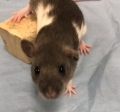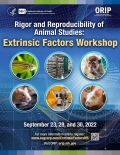

Enhance Rigor and Reproducibility in Animal Research by Managing Extrinsic Factors
When: September 23, 28, and 30, 2022
Venue: Zoom
Register: scgcorp.com/ExtrinsicFactorsWS
The workshop will be a forum to discuss the current status of and needs for understanding extrinsic environmental factors; their potential impact on animal research outcomes; and how facilities may optimally manage, monitor, and report these extrinsic factors in an effort to enhance reproducibility and rigor in animal research. The focus of this workshop will be on identifying gaps, opportunities, and new approaches in husbandry of commonly and widely used animal models; relevant environmental factors and conditions; and the need for novel instruments, equipment, and infrastructure for animal research core facilities (e.g., modern design of research core facilities, high-throughput equipment, telemetry for behavioral research).
The primary function of the RRRC is to supply biomedical investigators with the rat models, embryonic stem cells, related reagents, protocols and specialized services they require for their research.
The RRRC provides a unique repository service to the biomedical community by importing, storing and distributing a vast number of rat strains; as well as performing research that improves the function of the Resource Center.
In addition to repository, cryostorage and distribution functions, the RRRC can facilitate acquisition of rat strains from other international repositories as well as provide specialized services, consultation and technical training to investigators using rat models.
